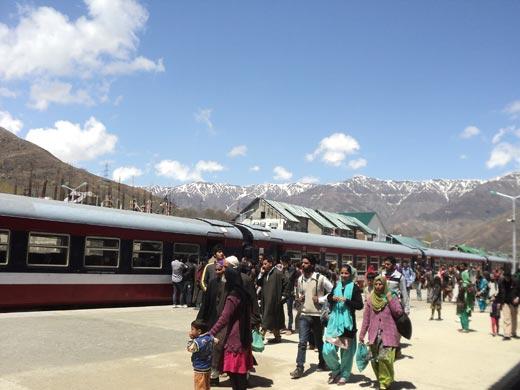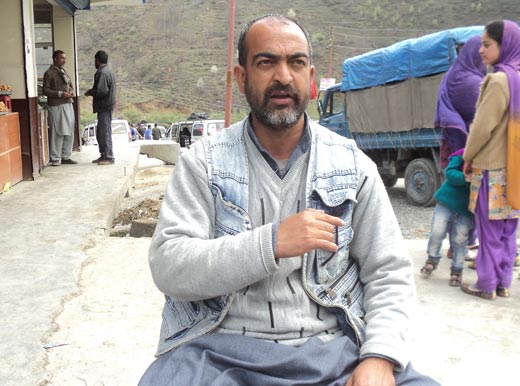The overcrowded rail piercing through the rugged Pir Panchal has not improved accessibility only. It has helped Banihal gradually integrate with Kashmir’s socio-economics and change its profile, reports R S Gull

Photo: Bilal Handoo
Kachkote hamlet in the periphery of Banihal was seemingly so distant that people avoided getting there after the sunset. Now it is the most crowded place in this highway town because it houses the railway station. On daily basis more than seven thousand people reach this spot for travelling to Srinagar. It obviously is the most crowded place in the town and busiest too.
“When the train stops here, by an average it sends passengers for not less than seventy taxis,” says Nazir Ahmad, a taxi driver from Islamabad who is operating from Banihal for last many months. “This taxi stand has its own sixty members and then taxis come from Jammu and Islamabad and even Srinagar to manage part of the load.”
Banihal has remained the gateway of Kashmir after the post-partition situation enforced a new communication order. It is not a base station. Lots of people, who leave Kashmir or enter into it, report to Banihal. Earlier, it was the situation on Jawahar Tunnel that was key to travel plans. That is over now. It is now Ramban-Ramsu-Nashri belt that is the worry. The tunnel has taken care of Pir Panchal as it rarely closes.
“It is the most cost effective and fast transport system,” says a senior railway official, who is authorized not to talk on record. “From Qazigund to Banihal, it costs Rs 60 for an hour long travel and the train takes only 18 minutes at a cost of Rs 5. Why would not people love it?”
But people have stopped loving it more. The train is plying dangerously crowded. Feeling one’s odour is common but now passengers are sweat-sharing routinely. The train services is available five times a day, for six days but it lacks the capacity of any additional bogey. A train can not have more than eight coaches.
“These are diesel multiple units and they have limited haulage capacity,” an official said. “You need to either change the DMU or get in more trains so that the rush is managed properly.”
For railways, the service is getting increasingly non viable. Officials think the ticket is too cheap and the costs on maintenance of operations are too huge. “It is not a subsidized ticket,” said one middle rung official. “It is literally free – Rs 20 from Banihal to Srinagar.” This is one of the reason, why the railways feels awkward in informing the society that it is not even in a position to appoint the staff, it desperately requires. The service is running with 40 per cent sanctioned staff positions vacant and that is not good news for better operations. Situation can aggravate as the load is increasing. From tourists to employees, rail is emerging a better choice because it is smooth ride and cost effective.

Regardless of how the Railways saves its face, the service has triggered a massive change in Banihal. “We have two trains which are massively overloaded – the first in the day and the last one,” says Mohammad Taskeen, a reporter who knows the belt like the palm of his hand. “The first train has around 200 students who regularly go to Isalmabad and Srinagar for their studies and 250 others are the patients who leave in the first service to see their doctors.” The last train that leaves from Banihal is overloaded because people landing from Jammu after six-hour tiring journey use this service to enter Kashmir.
Taskeen says the healthcare in the town and its peripheries has improved tremendously because of the train. “Ever since the train started, I have not heard any woman dying in childbirth,” he said. The Lal Ded born babies are growing in numbers.
“I have my newly built house with cracked walls,” says Mushtaq Ahmad near Gund Banihal. “The damage was caused when they were laying the tunnel but once it started I felt a change because this service is helping us to survive better. We have access to good education and healthcare.”
But that is just part of the story that rail has scripted on either side of the Pir Panchal. Right now the situation is that people living on either side of the mountain are marrying their wards. “We are no more the Banihal that was far away. We are accessible now,” said Abdul Hameed, a shopkeeper who has attended a ceremony last autumn. “It is getting us closer.”
Shortening of the distance has impacted the local business heavily. “Almost seventy per cent of the business has dealings with Srinagar now because it makes a business sense,” says Ali Mohammad Dar, a kiryana dealer. “We source hardware and medicines from Jammu and rest of it is coming from Srinagar.” The most important shift in the lives of the town is that to-be-brides and grooms are purchasing their wedding dresses from Srinagar. The interesting flipside of the story is that young boys and girls from Kashmir go romancing to Banihal and return home in the evening!
The town that was surviving on tea stalls, small time commercial shelters and the herds is now ascending the God given mobility trajectory. The rail and the upcoming road project has led to massive investment especially in the real estate.
Mushtaq Ahmad is amazed by the appreciation in the land prices in Banihal especially around Katchkote. “It was barely Rs 70,000 a few years back and we sold a kanal to railways for not more than Rs 1.5 lakhs,” Ahmad said. “Then the road project came and the prices were enormously up – it was Rs 5 lakh plus and now when rail is running, a kanal around the station is Rs 20 lakhs and even more.”

Reyaz Ahmad Wani is the new millionaire who has a strong presence outside the railway station. “I had the land outside the station, so I invested around Rs 35 lakh and creating the biggest commercial building which has 22 shops, a few eateries,” Wani said. “I make around half a million rupees as rent only a year and now I am planning hotel on the two more floor of the complex.” He already is a major transporter and owns a commercial fleet.
It is in front of his complex that has best wide-road infrastructure and now most of the politicians feel it easy to gather there supporters and hawk their policies and ideologies. During the last few weeks, it hosted two major crowds, one by Ghulam Nabi Azad and another by former officer Bashir Ahmad Runiyal who is planning to get into politics.
In fact it is Reyaz’s clan that surrounds the station. He has his brother owning one building and brother-in-law the other one. The ownership of the parking lot has automatically given him the right to decide on transportation issues. He says he ensures there is no fleecing.
“We exercise control over the taxis that we own locally and they follow the fare structure that the local union decides,” says Reyaz. “But we lack any control over the operators who are from Jammu or Islamabad. It is this group that overcharges at the cost of our reputation.” Though the rates per head from Banihal to Jammu are not more than Rs 200, there are reports about passengers being charged more than Rs 500. “There is a variation in rates. In autumn the rate from Srinagar to Jammu goes up and it is the same trend in spring from Jammu to Srinagar.”
Transport apart, the town has had a jump in the number of eateries and the level of accommodation is gradually improving. Passengers who reach late from Jammu or Srinagar do prefer staying in the town for the night and that has given flip to the hospitality sector improving the services.
But there is an interesting issue involved with the new investments taking place in the town. Why are people investing on basis of the rail traffic when they know, it is just a halt as the train has to move towards Udhampur?
Reyaz says he and the other investors are aware of the fact that Banihal is basking in the glory of delay in implementation of the project. “But we know, what is happening inside the mountains,” Reyaz said. The track has to go to Khadi, the next halt and it envisages a tunnel of 8 kms. “So far, only two kms of the tunnel has been dug and IRCON officials who work on the project say the completion of the track will take next 25 years.” A quarter century is enough to make best from the existing footfalls. Is not it!
















hi i needed a reliable taxi service from banihal to udhampur for my family which is in srinagar. If possible can u provide the mobile number and name of taxi service. I will be thankful to you.
my mobile no is 8087118982